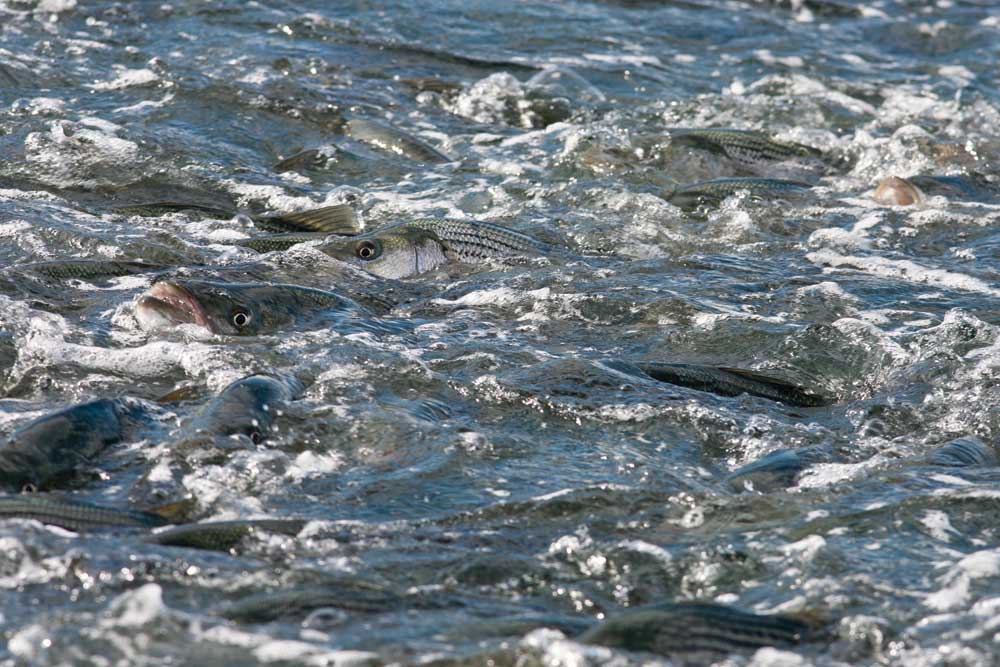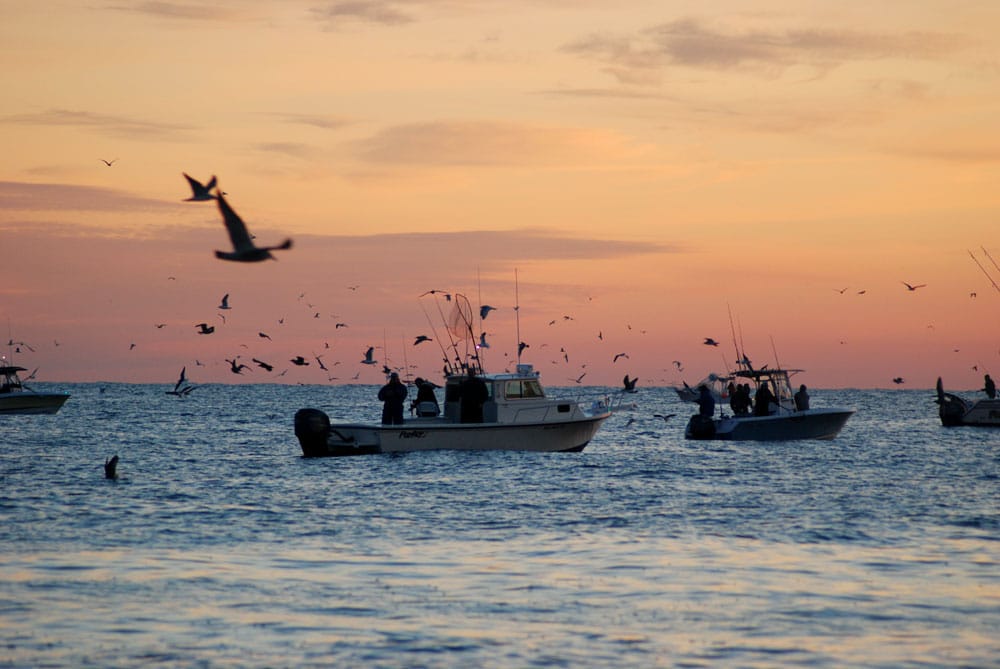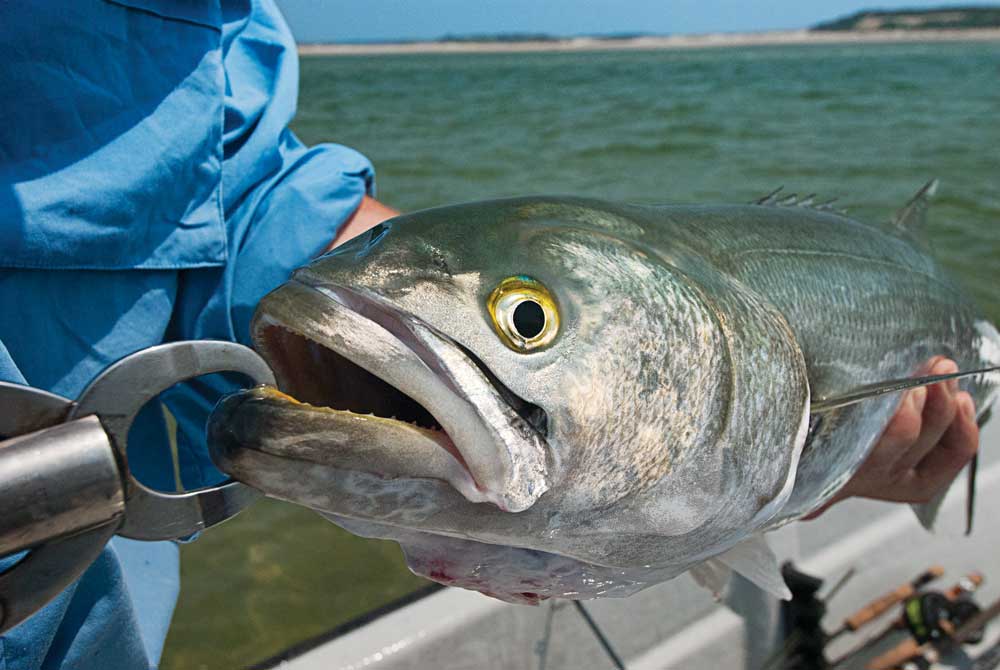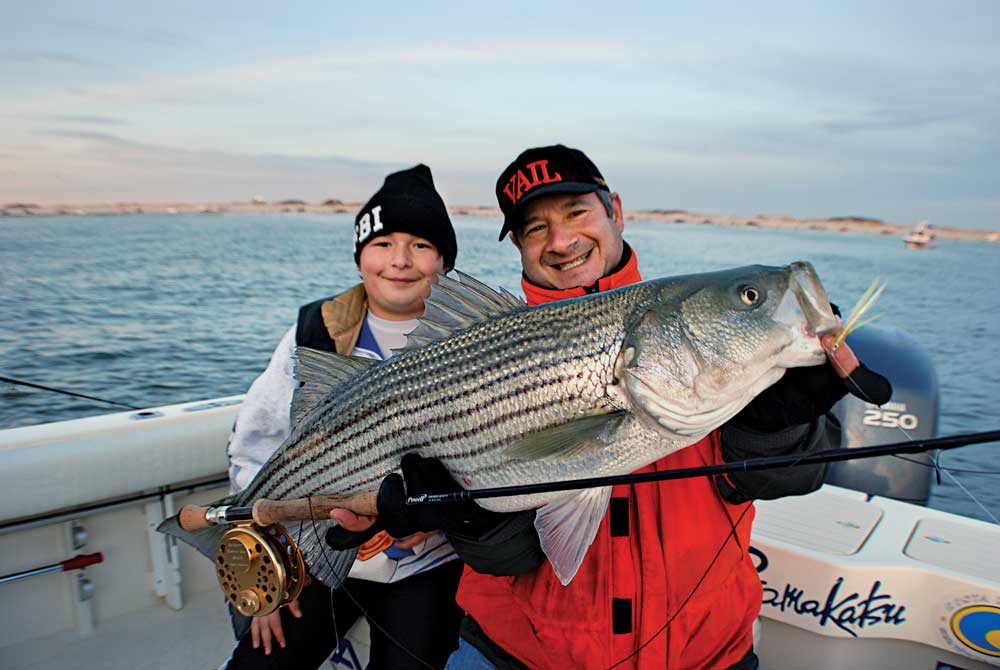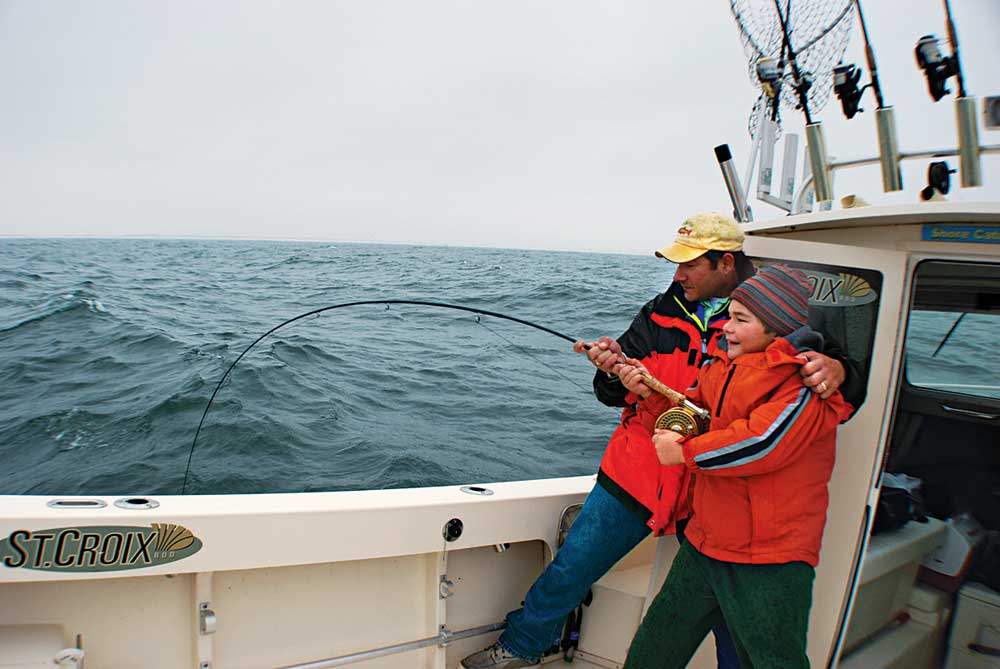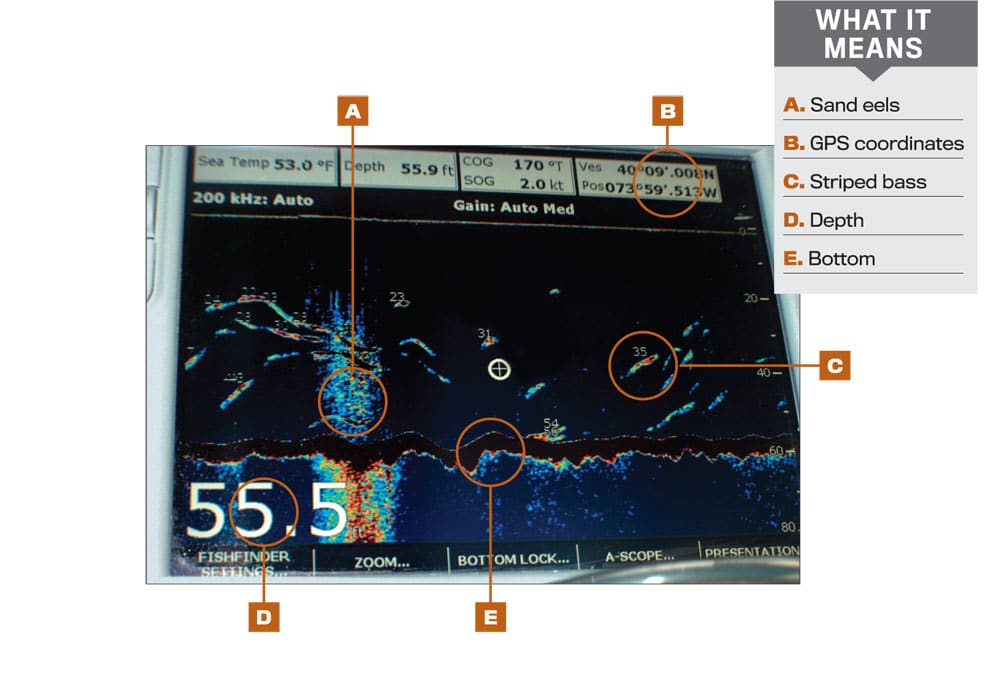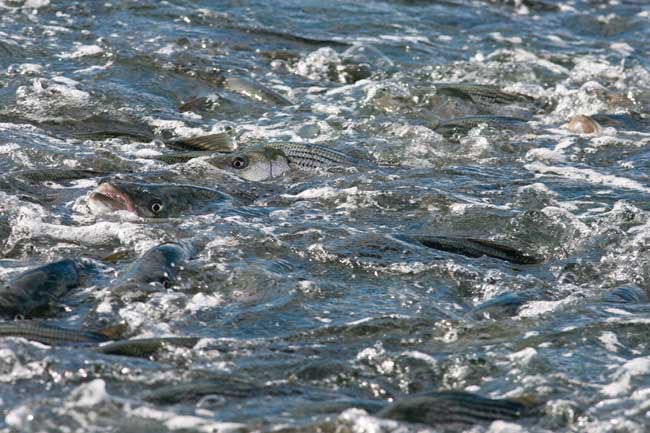
Winter Bass main
It was a seasonable December morning, as we were graced with air temperatures in the low 40s and light winds out of the northwest that made the surface of the sea look oil slick calm. My clients were wise to the hype that fishing this time of year can be downright gangbusters, and because of that, they had high expectations of hooking into one striped bass after another. You see, we were in the peak of the striped bass migration, when these fish move past the central New Jersey coast on their way south. I assured them that this was the case and that this was the best and easiest time of year to catch good numbers of stripers on fly.
As we broke the inlet, I told them that the telltale sign of locating striped bass in numbers would be to spot wads of diving gulls and gannets. We would pull up on the action, take a cast, dump some line and take a few quick strips, and they would come tight with their rods candy-caned over the gunwales.
In December, scenarios like this make the coast of central New Jersey an attractive place to be for fly-fishers when many have already put their long rods away. Perhaps the approaching holiday season and family obligations, and cold weather that comes with them, keep folks off the water; however, those that remain on the water are always handsomely rewarded.
During the early winter, expect to find fish arriving from New England and see massive blitzes all day. Bass typically range in size from 24 to 36 inches, but keep in mind that it’s not uncommon to find yourself tethered to a 30-plus-pound fish. On fly, these bass are a blast to catch, and it is not impossible to have 100 fish days from the boat. This means that just about every cast produces a fish. You can literally have hundreds of bass right beneath your boat.
**Tip 1 **
Since bass can be present over a wide vertical distribution, it will be to your advantage to carry as many pre-rigged rods with different line weights as you can. This way you can quickly grab the right tool for the right situation when you find the fish. You won’t have to worry about changing heads or spools on a boat that could very well be bouncing around. If you need an intermediate line or a quick sinker, it will be readily available.
Key Factors: Dropping Water Temperature and Baits
The actual migration period of striped bass in my guiding area begins in November. Dropping water temperatures are the key impetus to getting baits moving. This in turn stimulates stripers and bluefish to feed heavily as they prepare to migrate to their wintering grounds off of the Carolinas. Since both of these species are cold-blooded vertebrates, they will innately respond to temperature changes in their environment. Their metabolisms do not allow them the ability to maintain a homeostatic or steady internal body temperature. So dropping water temperatures will dictate and limit where and when they can be found and how they will feed.
Both of these species become very active in terms of their feeding behavior at the lower 10 degrees of their comfort range. This would be when water temperatures are dropping from 56 to 46 degrees. This temperature drop is predictable to a certain degree, barring any icy Arctic cold fronts that could come down out of Canada. I have kept water temperature logs for years, so I know the time frame of this event outside of my home port will be sandwiched between the second week of November through Christmas.
The prime temperature drop that I wait to see is when the water drops from 50 to 48 degrees. This is when the greatest concentration of striped bass are located in my guiding area.
Two Key Baits
Anglers should be aware of two key baits that move inshore along our coast during this 10-degree temperature window that will be the primary forage for striped bass and bluefish. Sand eels and Atlantic sea herring will be gorged upon on a daily basis and are what keep the stripers and bluefish in the area.
Sand eels normally appear first in the migration as they move in from cooler, deeper offshore waters. When the inshore waters cool, the range of the sand eels will shift from east to west. They can take up residence in the surf zone, but there is no guarantee that they will do so.
By boat, one will have a much higher degree of success in locating sand eels as they concentrate in large numbers over sandy bottoms. When you utilize a fish finder, sand eels will appear as tightly packed balls of bait on the screen. Most of the time, they will be in the bottom one-third of the water column.
Sea herring, also known as Atlantic herring, will appear inshore several weeks after the sand eels have arrived.
As for sea herring, these baits will pass through the surf zone but will not hold or concentrate in a particular area like sand eels do. They are simply passing through. Sea herring are open-ocean fish that travel in schools of hundreds or thousands; single fish are seldom seen.
If you are fishing the beach, the best location to find these baits is around the mouths of inlets or in the inlets themselves. If you are fishing from a boat, once again, look for groups of diving gannets or gulls to locate sea herring. These flocks of birds almost always hover over schools of marauding bass. I have witnessed some amazing sights during December, when schools of 20- to 30-pounders savagely attack bait right next to the boat. On many occasions, as one bass is hooked and is being coaxed to the boat, about a half-dozen other bass will follow and try to steal the fly from its mouth.
Tip 2
For intermediate lines, you will definitely want to use one of the clear, cold-water striper lines that are on the market. These lines will coil less in the chilled water than traditional style lines. Line coil will only add to your frustration level and reduce the distance that you can achieve with each cast.
Flies to Use
When sand eels are the dominant bait, a long, slender-profile fly such as Bob Popovics’ Jiggy works best. The weighted heads of these flies impart a nice jigging action to the fly as you make your retrieve. Olive, chartreuse, yellow and white consistently produce. Clousers, Half-and-Halfs, Farrar’s Silly Skin Eel, flat wings and tube flies will also receive positive responses.
I like fishing sand-eel patterns on a fast sinking line or shooting head so the fly can get down deep. Often, I’m fishing in water depths that range from 30 to 60 feet, and the deeper you can get your fly, the better the results you will have. The trick is to cast and quickly dump the head and all of the fly line into the water along with some of the backing before you start your retrieve. As the boat drifts away from the fly line, the line will eventually tighten. That’s when you begin stripping. Wait times can be as long as 45 to 60 seconds, depending on the line’s grain weight and sink rate. Usually, the first two or three long strips after this will draw a strike.
If the wind is up, however, and the drift is fast, you will need to cast and dump line upwind of the direction you are drifting, which allows more time for the line and fly to sink vertically. Many times in situations like this, I will throw a drift sock over the gunwales to slow the drift down to help get the flies down into the strike zone.
When fishing the surf or from a jetty, try fishing the same flies with a 200- to 300-grain sinking line or a clear cold-water intermediate striped bass line. Time your cast so that it falls on the backside of a wave rather than into the face of the white water, which would just push the line into the beach or onto the rocks rather than allowing it to sink.
When sea herring are the main baits you will want to fish large Popovics Bucktail Deceivers and Hollow Fleyes. Patterns like these cast easily, shed water and present a wide and long profile in the water. Also, large Lefty’s Deceivers, Dave Skok’s Mega Mushy, Half-and-Halfs, big synthetic bunker flies or other herring patterns will also work. I’ve found that these flies are best fished on clear cold-water intermediate or floating lines from the boat or in the surf. Sea herring will be pushed to the surface by feeding bass, so the upper 10 feet of the water column is the typical strike zone when sea herring are present. As a stripping method, two-handed retrieves are favored for two main reasons. First is that this type of retrieve gives the angler more line control, and second, it accurately mimics the constant swimming motion of herring.
Tip 3
This time of year cold hands and fingers plague anglers and need to be dealt with so they can maximize their time on the water. Thin, warm, waterproof gloves will keep your hands nice and toasty and still allow you to feel the line in your stripping hand, which helps you know what your fly is doing in the water.
Strategies to Employ
There are two types of strategies that I employ this time of year to catch bass and blues. I always look for the visual clues of diving gulls and gannets that pinpoint the action. A pair of binoculars or finely tuned radar can help tremendously, but even better is a network of buddies on the radio or cell phone. It’s not uncommon to have a lifeless ocean in one area and then run five to 10 miles and find all kinds of mayhem. It goes without saying that working with a network of captains, as we do, can be extremely advantageous. Being in the right place for the first two hours of the morning is extremely important. As boat traffic builds, the action can quickly shut the bite down.
If this first quick-fix strategy doesn’t pan out, then I will utilize the eyes of my fish finder to put us onto fish. As the bait moves parallel to the beach, it usually does so over specific depths. Last year, the bulk of the migration took place in 40 to 50 feet of water. But every year is different, so it can become a “seek and find” mission. When the bass are here, daily wind conditions may move the schools in closer or out deeper from day to day. Sometimes moving from 40 feet of water out to 60 feet is all it takes. So as a rule of thumb, I will not fish where I am not reading fish. I move around until I locate a nice school.
On occasion our searching can sometimes bring us off the beach several miles, putting us in the 70-foot range. This is right inside the state legal three-mile line for catching striped bass. The water out at this depth is also a few degrees warmer than the temperature we find right along the beach. For this reason you can expect to find some big tackle-busting blues in the deep in the 10- to 15-pound range mixed in with the striped bass.
When fishing by the eyes of your fish finder it is important to know how to read it properly. You will find both bait and fish suspended at different depths below the surface. You should know what bait looks like and what bass and bluefish look like and be able to distinguish between them.
When looking at a dark bait cloud on the screen, many times you will see several big inverted hooks directly behind and just beneath the school. Usually these are those trophy bass that typically stay deep. If you are on a trophy quest, it would be best to stay with these schools as long as possible.
New Jersey Striper Tackle Bag
Rod and Reels: I really like using 9- and 10-weight fast action rods matched with quality reels lined appropriately when the bass and blues are in excess of 10 pounds. When the fish I’m seeing are smaller, I will opt for an 8-weight outfit.
Lines: Use Sink Tip cold-water striper lines with density compensated heads ranging from 330- to 550-grain with a sink rate of 7.2 to 9.5 inches per second. Intermediate lines come in handy when fish are feeding near or just below the surface.
Leaders: For intermediate lines, use a straight shot of an eight- to nine-foot fluorocarbon leader. For sinking lines, use a four- to six-foot fluorocarbon leader. Loop-to-loop the leader to the fly line’s welded loop. No tapering down of the leader is necessary.
Flies: For sand-eel patterns, use a long, slender, slim profile fly. My first choice is a Popovics Jiggy, but Clousers, Half-and-Halfs, Popovics’ Stick Candies and flat wings are good options too. For sea herring patterns, use Popovics’ Bucktail Deceivers and Hollow Fleyes as a first choice but also carry some large Lefty’s Deceivers, Skok’s Mega Mushy, Half-and-Halfs, big synthetic bunker flies or other herring patterns.
